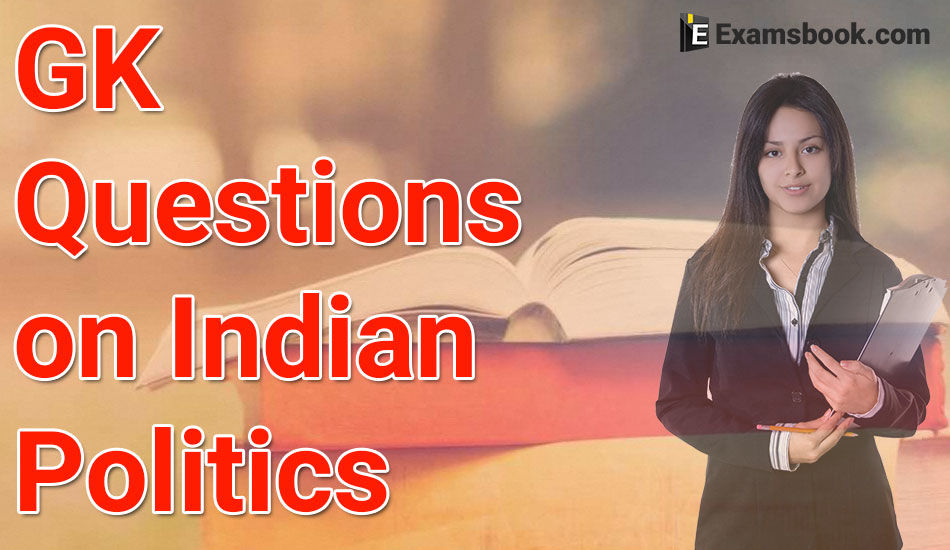GK Questions on Indian Politics for Competitive Exams

The Constituent Assembly which enacted the Constitution of Indian, its members were-
(A) Nominated by Political Parties
(B) Elected by the Legislative Assemblies of different provinces
(C) Directly elected by People
(D) Nominated by Governor General
Correct Answer : B
Explanation :
The Constituent Assembly was constituted in November 1946 under the scheme formulated by the Cabinet Mission Plan. The total strength of the Constituent Assembly was to be 389. Of these, 296 seats were to be allotted to British India and 93 to Princely States. Out of 296 seats allotted to British India, 292 members were to be drawn from the eleven Governors’ provinces and four from Chief Commissioners’ Provinces, one from each.
Which of the following act suggested the post of Comptroller and Auditor General-
(A) Act of 1909
(B) Act of 1919
(C) Act of 1935
(D) Act of 1947
Correct Answer : B
Explanation :
The CAG is n authority, established by the constitution under constitution of India. Part V- Chapter V/sub-part 7B/ Article 147, who audits all the receipts and expenditure of the government of India. Under the act of 1919, the Secretary of India was given the charge to appoint CAG in India.
Which of the following was the Chairman of Constituent Assembly of India-
(A) Dr. Rajendra Prasad
(B) Jawaharlal Nehru
(C) M.A. Jinna
(D) Lal Bahadur Shastri
Correct Answer : A
Explanation :
Dr. Rajendra Prasad served as the Chairman of the Constituent Assembly of India. He played a pivotal role in guiding the assembly members in drafting the Indian Constitution, which came into effect on January 26, 1950. His leadership and consensus-building skills were crucial in shaping the democratic foundation of the newly independent nation.
Liberalism is a symbol of–
(A) Liberalization
(B) Nature and Behaviour
(C) Freedom of Social, Political and Economic aspects
(D) Religious conservationism
Correct Answer : C
Explanation :
Liberalism is a political philosophy based on the ideas, freedom and equality. It includes Social, Religious, Political and Economic freedom and International Co-operation.
Which of the following forms are/is described for India in the preamble of constitution-
(A) A Sovereign, Democratic, Republic
(B) A Socialist, Democratic, Republic
(C) A Sovereign, Socialist, Secular Democratic Republic
(D) A Republic
Correct Answer : C
Explanation :
The Preamble reveals the nature of Indian state: It declares India to be a Sovereign, Socialist, Secular, Democratic and Republican polity. Words Socialist, Secular, Integrity were added by 42nd amendment on the recommendation of Sardar swarn singh committee constituted by the late PM Indira Gandhi.
Preamble to the constitution of India consists-
(A) Sovereign, Democratic, Socialist, Secular Republic
(B) Socialist, Democratic, Secular Republic
(C) Democratic, Sovereign, Secular, Socialist Republic
(D) Sovereign, Socialist, Secular, Democratic Republic
Correct Answer : D
Explanation :
Preamble to the Constitution of India is a brief intraductory statement that sets out the guiding purpose and principles of the documents and indicates the source from which the document derives its authority meaning, the people.
Where can we see the values of Indian democracy in the constitution?
(A) Preamble
(B) Part-3
(C) Part-4
(D) Part-1
Correct Answer : A
Explanation :
The values of Indian democracy can be traced in the Preamble of the Constitution. The 'Preamble' of the Constitution of India is a brief introductory statement that sets out the guiding objectives and principles of the document indicating the source from which the document derives its authority and meaning for the people.
Indian constitution not only imagines the democratic form of government but also imagines a democratic society, because its ideology consists of
1. Justice 2. Liberty 3. Equality 4. Fraternity
(A) 1 and 2
(B) 2 and 3
(C) 1 and 3
(D) 1,2,3 and 4
Correct Answer : D
Explanation :
Indian constitution works on the ideology of Justice, Liberty, Equality and Fraternity.
Who was the chairman of the Constituent Assembly of India-
(A) Dr. B.R.Ambedkar
(B) Dr.Rajendra Prasad
(C) Dr. B.N. Rao
(D) Pandit Jawaharlal Nehru
Correct Answer : B
Explanation :
The Constituent Assembly held its first meeting on Dec.9,1946. The meeting was attended by 211 members. Dr. Sachchidanand Sinha, the oldest one,was elected as the temporary president of the assembly. Later on, Dec.11,1946, Dr. Rajendra Prasad and H.C. Mukherjee were elected as the President and vice-president of the assembly.Sir B N Rau was appointed as the Constitutional Advisor in the assembly.
How many members were in the interim Parliament of India-
(A) 296
(B) 313
(C) 318
(D) 316
Correct Answer : A
Explanation :
The interim government of India formed on 2nd September 1946 from the newly elected constituent assembly of India. There were 296 members in interim parliament of India.



